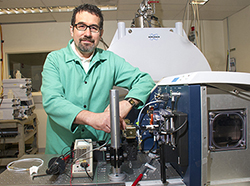Pinpointing the Pathogen
 |
|
Biologist/chemist Dan Fabris stands in the Life Sciences Research Building alongside the mass spectrometer he is using to chart the paths of RNA PTMs to find pathogens in milk. (Photo by Mark Schmidt) |
Albany, N.Y. (July 10, 2017) — The price tag for tossed milk, lost production and cow mastitis in New York State is approximately $187 million per year. That’s why an investment by the State University of New York in the research of chemist/biologist Dan Fabris may mean big returns for dairy farmers and consumers.
Fabris, a leading scientist with The RNA Institute at UAlbany, received one of four new SUNY Technology Accelerator Fund (TAF) awards for a new technology that allows for fast, accurate, comprehensive and inexpensive identification of infections, diseases and pathogen contamination in biological samples.
The test trial supported by the TAF tests the applicability of Fabris’s technology to identify pathogens in milk. Currently, tests for pathogens in milk occurs when the dairy farmer sees cows that seem ill or when milk looks bad. Trial and error tests to find a bacterial infection can be numerous and costly.
Worse, a cow may seem fine but actually have infection. If its milk is added to a large collection vat and the pathogen detected, the entire contents of the vat must be tossed. Non-detection could lead to product recalls and, worse, human illness. Added to this, bacteria-infected cows are taken off the production line and treated with antibiotics, which more often than not are ineffective, and the cow is destroyed.
The Basic Science
Fabris’s research involves post-translational modifications, or PTMs, markers placed on natural RNA by different enzymes present in a cell. PTMs carry out yet unknown biological functions, but PTM patterns can be correlated with specific infections, diseases and cancer. Using mass spectrometric analysis of milk samples, Fabris and his research team will detect the PTM patterns that correlate with pathogens — in the TAF trial, with pathogens in milk.
“Completion of the pilot will lead to the development of a portable instrument that in a single test will enable the farmer to identify the presence of any type of microorganism in milk,” said Fabris. This would include numerous bacteria that cause mastitis of milk cows, such as Staphylococcus aureus, Streptococcus uberis and Escherichia coli, or induce major health problems upon product consumption by humans, including E. coli, salmonella, and listeria.
“In our case, a single test will tell what is present in milk — no trial-and-error,” said Fabris. “The farmer will have to buy the portable instrument, but the initial up-front cost will be rapidly offset by the ability to perform a very large number of analyses, day after day, on milk from individual cows, or pools of milk collected in vats.”
Beyond the Dairy Trial
The new testing technology has broad applications, working on any type of biological sample and any type of pathogen. “We chose to go after milk [in the TAF trial] because regulations are lower than for human diagnostics, and the potential for generating revenues in a short order is very high,” he said.
The same type of portable instrument could someday be placed in the hands of physicians, allowing a doctor to know what infection is within a patient and what must be prescribed even before the patient walks out the door. The success of the TAF trial will be a key to the future research and eventual commercialization of Fabris’s technology.
“The direct correlation between PTM patterns and specific infections or diseases can be immediately used in human diagnostics and pathogen-detection applications,” said Marlene Belfort, interim director of The RNA Institute, of Fabris’s technology. “It’s exciting that implementing the technology in the food-safety market will have immediate economic impact.
“The potential of future pilot studies to address other areas of infectious disease detection is a clear indication of the good science being produced at The RNA Institute.”
![]() For more news, subscribe to UAlbany's RSS headline feeds
For more news, subscribe to UAlbany's RSS headline feeds
A comprehensive public research university, the University at Albany-SUNY offers more than 120 undergraduate majors and minors and 125 master's, doctoral and graduate certificate programs. UAlbany is a leader among all New York State colleges and universities in such diverse fields as atmospheric and environmental sciences, business, education, public health,health sciences, criminal justice, emergency preparedness, engineering and applied sciences, informatics, public administration, social welfare and sociology, taught by an extensive roster of faculty experts. It also offers expanded academic and research opportunities for students through an affiliation with Albany Law School. With a curriculum enhanced by 600 study-abroad opportunities, UAlbany launches great careers.


